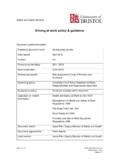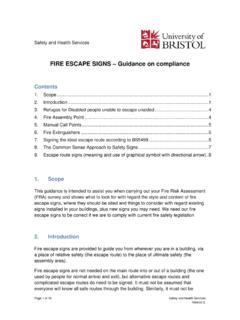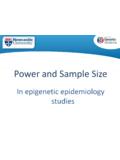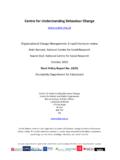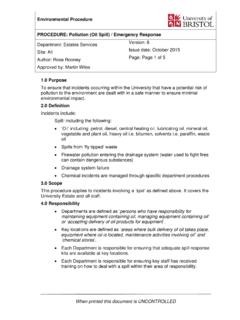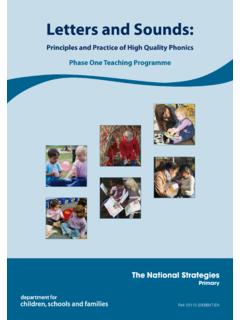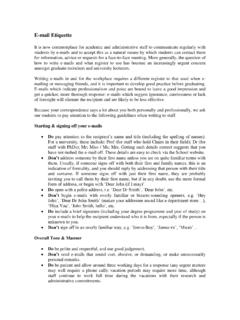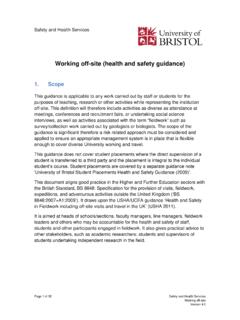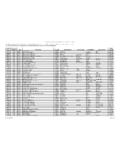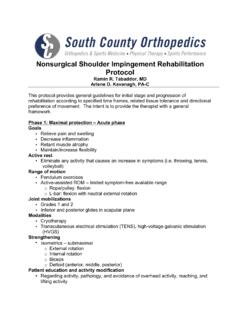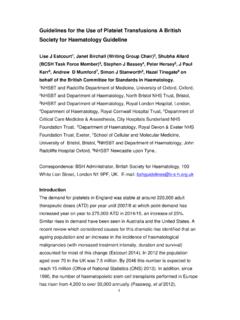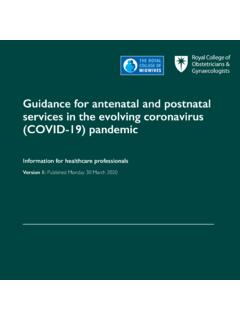Transcription of ROBIS: Tool to assess risk of bias in systematic reviews ...
1 ROBIS: Tool to assess risk of bias in systematic reviews Guidance on how to use ROBIS. Penny Whiting (Kleijnen systematic reviews Ltd, University of Bristol), Jelena Savovi (University of Bristol). Julian Higgins (University of Bristol), Deborah Caldwell (University of Bristol). Barnaby Reeves (University of Bristol), Beverley Shea (University of Ottawa). Philippa Davies (University of Bristol), Jos Kleijnen (Kleijnen systematic reviews Ltd, Maastricht University), Rachel Churchill (University of Bristol). 1. Contents The ROBIS Tool .. 4. Definition of risk of bias .. 4. Target audience .. 4. Phase 1: Assessing Relevance (optional).
2 4. Example Relevance Assessment3 .. 6. Phase 2: Identifying concerns with the review 7. Domain 1: Study eligibility criteria .. 8. Background .. 8. Example ratings .. 11. Domain 2: Identification and selection of studies .. 14. Background .. 14. Example ratings .. 16. Domain 3: Data collection and study appraisal .. 18. Background .. 18. Example ratings .. 21. Domain 4: Synthesis and findings .. 23. Background .. 23. Example ratings .. 28. Phase 3: Judging risk of 30. Example ratings .. 32. Appendix: Glossary .. 38. 2. Tables Box: Examples of target questions and PICO equivalents for different types of systematic review.
3 5. Table 1: Signalling questions for Domain 1 with guidance on how to answer each question .. 9. Table 2: Concerns regarding specification of study eligibility criteria .. 10. Table 3: Example rating for specification of study eligibility criteria judged at high concerns .. 11. Table 4: Example rating for specification of study eligibility criteria judged at low concerns .. 12. Table 5: Signalling questions for Domain 2 with guidance on how to rate each question .. 15. Table 6: Concerns regarding methods used to identify and/or select studies .. 16. Table 7: Example rating for search strategy judged at high concerns .. 16.
4 Table 8: Example rating for search strategy judged at low concerns .. 17. Table 9: Signalling questions for Domain 3 with guidance on how to rate each question .. 19. Table 10: Concerns regarding methods used to collect data and appraise studies .. 20. Table 11: Example rating for data collection and study appraisal judged at high concerns .. 21. Table 12: Example rating for data collection and study appraisal judged at low concerns .. 22. Table 13: Signalling questions for Domain 4 with guidance on how to rate each question .. 24. Table 14: Concerns regarding methods used to synthesize results .. 27. Table 15: Example rating for synthesis judged at high 28.
5 Table 16: Example rating for synthesis judged at low concerns .. 29. Table 17: Signalling questions for Phase 3 with guidance on how to rate each question .. 31. Table 18: Risk of bias introduced by methods used to identify and/or select studies .. 31. Table 19 Summary of concerns identified during the Phase 2 assessment .. 32. Table 20: Example rating for synthesis judged at high risk of bias .. 33. Table 21 Summary of concerns identified during the Phase 2 assessment .. 33. 3. The ROBIS Tool The tool is completed in 3 phases: (1) assess relevance (optional), (2) identify concerns with the review process and (3) judge risk of bias in the review.
6 Signalling questions are included to help assess specific concerns about potential biases with the review. The ratings from these signalling questions help assessors to judge overall risk of bias. Definition of risk of bias ROBIS assesses both the risk of bias in a review and (where appropriate) the relevance of a review to the research question at hand. Specifically, it addresses 1) the degree to which the review methods minimised the risk of bias in the summary estimates and review conclusions, and 2) the extent to which the research question addressed by the review matches the research question being addressed by its user ( an overview author or guideline developer).
7 Bias occurs if systematic flaws or limitations in the design, conduct or analysis of a review distort the results. Evidence from a review may have limited relevance if the review question did not match the overview/guidelines question. Target audience ROBIS was developed with three specific user groups in mind: Authors of overviews of systematic reviews Guideline developers Reviewers who may want to assess risk of bias in their review once it is complete or to minimise the risk of bias when planning the review methods at the protocol stage It may also be helpful for anyone who wants to assess the risk of bias in a systematic review, however, it has not been specifically designed for other target audiences.
8 Other potential users of ROBIS include organisations supporting decision making ( NICE, IQWiG), clinicians with an interest in evidence based medicine, journal editors and manuscript reviewers. Phase 1: Assessing Relevance (optional). Assessors first report the question that they are trying to answer ( in their overview or guideline). we have called this the target question . For efficacy or effectiveness reviews they are asked to define this in terms of the PICO (participants, interventions, comparisons, outcomes). For reviews of different types of questions ( diagnostic test, prognostic factors, aetiology or prediction models), alternative categories are provided as appropriate (see box).
9 Assessors complete the PICO or 4. equivalent for the systematic review to be assessed using ROBIS, and are then asked whether the two questions (target question and systematic review question) match. If one or more of the categories (PICO or equivalent) do not match then this should be rated as No . If there is a partial match between categories then this should be rated as partial . For example, if the target question relates to adults, but the systematic review is restricted to participants aged more than 60 years. If a review is being assessed in isolation and there is no target question, then this phase of ROBIS can be omitted.
10 Box: Examples of target questions and PICO equivalents for different types of systematic review Review Type PICO equivalent Example 1. Intervention Patients/Population(s): Adults with chronic hepatitis C virus infection Intervention(s): Triple anti-viral therapy with pegylated interferon Comparator(s): Dual anti-viral therapy Outcome(s): Sustained virologic response 2. Aetiology Patients/Population(s): Adults Exposure(s) and comparator(s): Body mass index Outcome(s): Colorectal cancer 3. Diagnosis Patients): Adults with symptoms suggestive of rectal cancer Index test(s): Endoscopic ultrasound Reference standard: Surgical histology Target condition: Early rectal cancer (T0).
